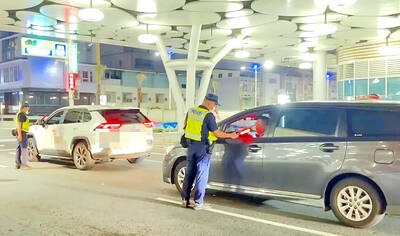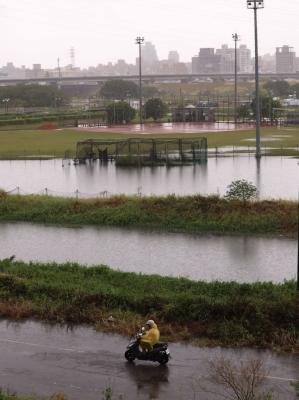A new budget law has prevented the central government from disbursing NT$34.5 billion (US$1.14 billion) to local governments, the Executive Yuan said yesterday, as heads of opposition-governed jurisdictions scheduled a meeting over funding for today.
The government has no choice but to withhold funding due to “unsolvable” problems and mistakes in the amended Act Governing the Allocation of Government Revenues and Expenditures (財政收支劃分法), Cabinet spokeswoman Michelle Lee (李慧芝) said.
The Chinese Nationalist Party (KMT) and the Taiwan People’s Party approved amendments to the legislation in March.

Photo: Taipei Times
The formula for calculating shares of the budget for special municipalities, as well as county and city governments, would leave the central government legally unable to distribute the total, Lee said.
The amendments would channel funding previously earmarked for central government programs to its local counterparts, without also transferring the responsibility for overseeing the projects, she said.
The changes made the private-sector profit, population and size of the 22 administrative regions factors to increase its budget, which most certainly would widen the urban-rural divide, Lee said.
The math issue lies in the inclusion by lawmakers of Taiwan’s outlying counties in a part of the law governing allocations in Taiwan proper, National Taipei University of Business professor of public finance and tax administration Huang Yao-huei (黃耀輝) told the Chinese-language Storm Media Group.
That means the denominator for calculating allocations increased to 22 from 19, resulting in a drop in revenues for each jurisdiction and hanging tens of billions of New Taiwan dollars “in the air,” Huang said.
The 16 KMT and TPP mayors and commissioners said that they would convene a news conference in Taipei today to comment on the drop in revenues for regions including Lienchiang and Yunlin counties.
Taichung Mayor Lu Shiow-yen (盧秀燕) said that the Executive Yuan informed local governments that subsidies planned in the previous year had been canceled and that they should expect a drop in subsidies.
The regulations governing local subsidies were changed from giving local governments funds that had been calculated by a formula to a discretionary decision by officials, Lu said, adding that the practice led to unfairness.
Kaohsiung, which has a smaller population than Taichung, received NT$130 billion in subsidies compared with the NT$20 billion earmarked for Taichung, she said.
The DPP government is used to picking political fights with the legislature, and has turned its attention to local administrations, she said, adding that the central government should change its ways following its defeats in the recall elections.
Taipei Mayor Chiang Wan-an (蔣萬安) and New Taipei City Mayor Hou You-yi (侯友宜) are expected to attend today’s news conference, sources said.

TRAFFIC SAFETY RULES: A positive result in a drug test would result in a two-year license suspension for the driver and vehicle, and a fine of up to NT$180,000 The Ministry of Transportation and Communications is to authorize police to conduct roadside saliva tests by the end of the year to deter people from driving while under the influence of narcotics, it said yesterday. The ministry last month unveiled a draft of amended regulations governing traffic safety rules and penalties, which included provisions empowering police to conduct mandatory saliva tests on drivers. While currently rules authorize police to use oral fluid testing kits for signs of drug use, they do not establish penalties for noncompliance or operating procedures for officers to follow, the ministry said. The proposed changes to the regulations require

Taipei, New Taipei City, Keelung and Taoyuan would issue a decision at 8pm on whether to cancel work and school tomorrow due to forecasted heavy rain, Keelung Mayor Hsieh Kuo-liang (謝國樑) said today. Hsieh told reporters that absent some pressing reason, the four northern cities would announce the decision jointly at 8pm. Keelung is expected to receive between 300mm and 490mm of rain in the period from 2pm today through 2pm tomorrow, Central Weather Administration data showed. Keelung City Government regulations stipulate that school and work can be canceled if rain totals in mountainous or low-elevation areas are forecast to exceed 350mm in

The Executive Yuan yesterday announced that registration for a one-time universal NT$10,000 cash handout to help people in Taiwan survive US tariffs and inflation would start on Nov. 5, with payouts available as early as Nov. 12. Who is eligible for the handout? Registered Taiwanese nationals are eligible, including those born in Taiwan before April 30 next year with a birth certificate. Non-registered nationals with residence permits, foreign permanent residents and foreign spouses of Taiwanese citizens with residence permits also qualify for the handouts. For people who meet the eligibility requirements, but passed away between yesterday and April 30 next year, surviving family members

1.4nm WAFERS: While TSMC is gearing up to expand its overseas production, it would also continue to invest in Taiwan, company chairman and CEO C.C. Wei said Taiwan Semiconductor Manufacturing Co (TSMC) has applied for permission to construct a new plant in the Central Taiwan Science Park (中部科學園區), which it would use for the production of new high-speed wafers, the National Science and Technology Council said yesterday. The council, which supervises three major science parks in Taiwan, confirmed that the Central Taiwan Science Park Bureau had received an application on Friday from TSMC, the world’s largest contract chipmaker, to commence work on the new A14 fab. A14 technology, a 1.4 nanometer (nm) process, is designed to drive artificial intelligence transformation by enabling faster computing and greater power